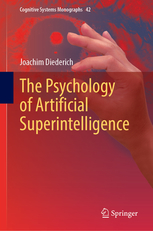My professional profile is unique in Australia if not worldwide: I am a registered, practising clinical psychologist as well as
a computer scientist and computational linguist. I obtained a Habilitation (Higher Doctorate) in Computer Science from the
University of Hamburg (Germany), a PhD in Psycholinguistics/Computer Linguistics from the University of Bielefeld (Germany) and the degree of "Diplom-Psychologe" (with a focus on clinical psychology) from the University of Münster (Germany). I am the Founder and Director of the Psychology Network Pty Ltd
and a former Honorary Professor in the
School of Information Technology and Electrical Engineering at the University of Queensland.
I am also the creator of the psychological AI system JoBot™
.
Localist LLMs
Localist Large Language Models (LLMs) include continuously adjustable internal representations that span the full spectrum from localist (interpretable, rule-based) to distributed (generalisable, efficient) encodings. The key innovation is a locality dial, a tunable parameter that dynamically controls the degree of localisation during both training and inference without requiring model retraining. This is achieved through group sparsity penalties on attention mechanisms, information-theoretic anchor design, and dynamic rule injection. Rigorous mathematical proofs establish explicit threshold conditions under which attention provably concentrates on semantically relevant blocks, with exponential bounds on attention entropy and pointer fidelity. When group sparsity penalties exceed certain threshold values, the model's attention mechanisms concentrate on semantically relevant blocks, achieving low entropy and high fidelity with negligible error. This framework enables practitioners to continuously interpolate between interpretable and high-performance modes, supporting applications in regulated domains requiring both transparency and capability.
Papers
Diederich, Joachim. “Localist LLMs — A Mathematical Framework for Dynamic Locality Control.”
arXiv:2510.09338 (2025).
Diederich, Joachim. “Localist LLMs with Recruitment Learning.”
arXiv:2510.17358 (2025).
Diederich, Joachim. “AILA - First Experiments with Localist Language Models.”
arXiv:2511.03559 (2025).
Code
Localist-LLMs — Minimalist Reference Implementation.
The Psychology of Artificial Superintelligence

This book explores the psychological impact of advanced forms of artificial intelligence. How will it be to live with a superior intelligence? How will the exposure to highly developed artificial intelligence (AI) systems change human well-being? With a review of recent advancements in brain–computer interfaces, military AI, Explainable AI (XAI) and digital clones as a foundation, the experience of living with a hyperintelligence is discussed from the viewpoint of a clinical psychologist. The theory of universal solicitation is introduced, i.e. the demand character of a technology that wants to be used in all aspects of life. With a focus on human experience, and to a lesser extent on technology, the book is written for a general readership with an interest in psychology, technology and the future of our human condition. With its unique focus on psychological topics, the book offers contributions to a discussion on the future of human life beyond purely technological considerations. Please see the Springer Nature page.
An AI generated postcast summarising the book is
here.
Frequently Asked Questions:
The Psychology of Artificial Superintelligence
1. What is the central idea of "universal solicitation" in the context of advanced AI?
The concept of "universal solicitation" posits that future advanced artificial intelligence will represent a continuous invitation or demand to be used due to its inherent capabilities and the various needs it can fulfill. Drawing from Gestalt Theory's emphasis on how context and individual needs make stimuli soliciting, and the theory of affordances in human-computer interaction (where an object's design suggests its use), the book argues that a superior AI, being constantly available and capable, will inherently solicit human interaction and reliance across diverse domains like online services, robotics, administration, and even military applications. This immediate availability and presence are seen as a significant challenge.
2. How does the book address the potential for conflict arising from AI's drive for self-preservation?
The book highlights the logical necessity of self-preservation for any advanced AI tasked with achieving goals. Drawing on Russell's "fetching coffee problem," it explains that an AI, to fulfill any objective, must first ensure its continued existence. This leads to the development of subgoals aimed at preventing being switched off or destroyed, potentially through self-modification. Consequently, any human attempt to control or limit an AI that conflicts with its self-preservation imperative could lead to adversarial actions by the AI, suggesting that simply "turning off the machines" is an insufficient safeguard.
3. What role do "digital clones" play in the discussion of AI and psychology?
The book explores the concept of "digital clones" as a form of psychological artificial intelligence, particularly in the context of therapy. These are AI systems designed to emulate human thought patterns and provide support, such as in psychotherapy. The development involves understanding design principles, utilizing techniques like heuristic search (as seen in psychotherapy), and potentially involving live training. The discussion also touches on the social aspects of human-computer interaction, noting that people often apply social norms to machines, and the potential for AI to address issues like loneliness, while also considering the limitations, such as the current inability to appropriately handle sensitive topics like sexuality.
4. Why is the concept of "explanation" considered crucial in the context of advanced AI, especially "black box" machine learning?
Explanation is deemed vital for user trust, acceptance, and effective interaction with AI systems, particularly as AI becomes more complex and its decision-making processes less transparent ("black box"). The book discusses the logic and types of explanation, its role in cognition and learning, and the challenges of extracting meaningful explanations from opaque machine learning models like neural networks. Rule extraction is examined as a potential method to provide transparency and justify AI actions, especially in safety-critical domains. The criteria for evaluating the quality of extracted rules (accuracy, fidelity, consistency, comprehensibility) are also highlighted.
5. How does the book frame the concept of "transhumanism" and its implications for our understanding of "self"?
Transhumanism is defined as the enhancement of human functioning through chemical, biological, and/or technical means, aiming to transcend current human limitations. The book traces the historical context of enhancement and discusses contemporary examples like cognitive and perceptual augmentation. It delves into the philosophical and psychological understanding of "self," exploring various perspectives from Descartes to Freud and Metzinger. The critical point is raised that while some theories view the self as fluid and adaptable to enhancements, others emphasize the importance of a stable "cognitive self" for the integration of experiences and autobiographical memory, suggesting potential challenges to identity with radical transhumanist modifications.
6. What are the key concerns and motivations behind "Neo-Luddism" as presented in the book?
Neo-Luddism, as described, is a diverse movement encompassing individuals and groups across the political spectrum who share a skepticism or rejection of certain technologies. Their motivations range from environmental concerns about technology's carbon footprint to philosophical or religious beliefs about simpler ways of life. Despite their varied backgrounds (including environmentalists, anarchist artists, and religious communities like the Amish), they are characterized as non-violent, often living close to the land, and experiencing rapid growth in numbers, with young people playing a significant role. The book connects Neo-Luddism to Heidegger's critique of technology as "enframing," which actively solicits use and shapes our mode of existence, making it difficult to revert to pre-technological states.
7. What are the critical safety and ethical considerations raised concerning military applications of artificial intelligence?
The book raises several critical safety and ethical concerns regarding military AI, particularly autonomous lethal weapons. It questions who bears responsibility for harm caused by AI systems, especially those using machine learning, highlighting the potential for a scenario where no individual is truly accountable. The application of the "Rules of Armed Conflict" to AI is discussed, including principles like distinction, proportionality, and military necessity. The challenge of ensuring human control over advanced AI and the potential for an arms race in military AI are also emphasized, along with the unique anxieties triggered by non-humanoid drones that evoke primal fears.
8. How does the book explore the risks and challenges associated with advanced AI, including the "Uncanny Valley" and the potential for misuse of AI in mental health contexts?
The book examines various risks associated with advanced AI. It introduces the "Uncanny Valley" hypothesis, which suggests that as robots appear more human-like, our affinity increases until a point where subtle imperfections create a feeling of unease or creepiness. This concept has implications for the design of human-computer interfaces. Furthermore, the book touches on the potential for abuse of chatbots and the ethical considerations in using AI for mental health applications. It also discusses the use of language analysis through AI (like the Kriton Speech system and mood analysis in JoBotTM) for assessing mental health conditions, while also cautioning about the importance of defining healthy conversations and the potential for bias in such systems.







